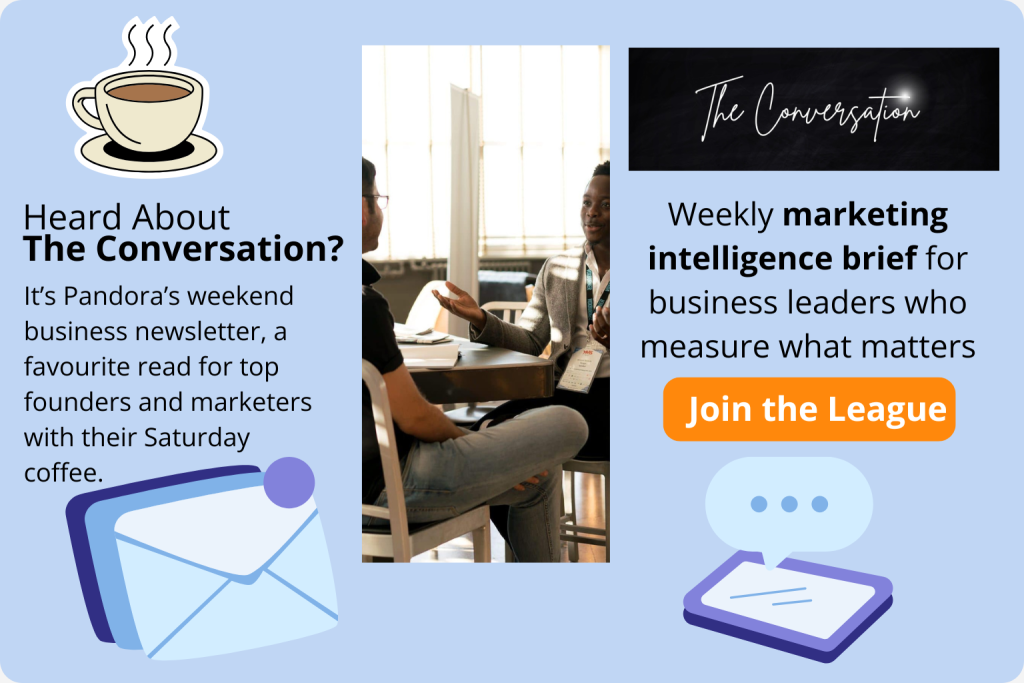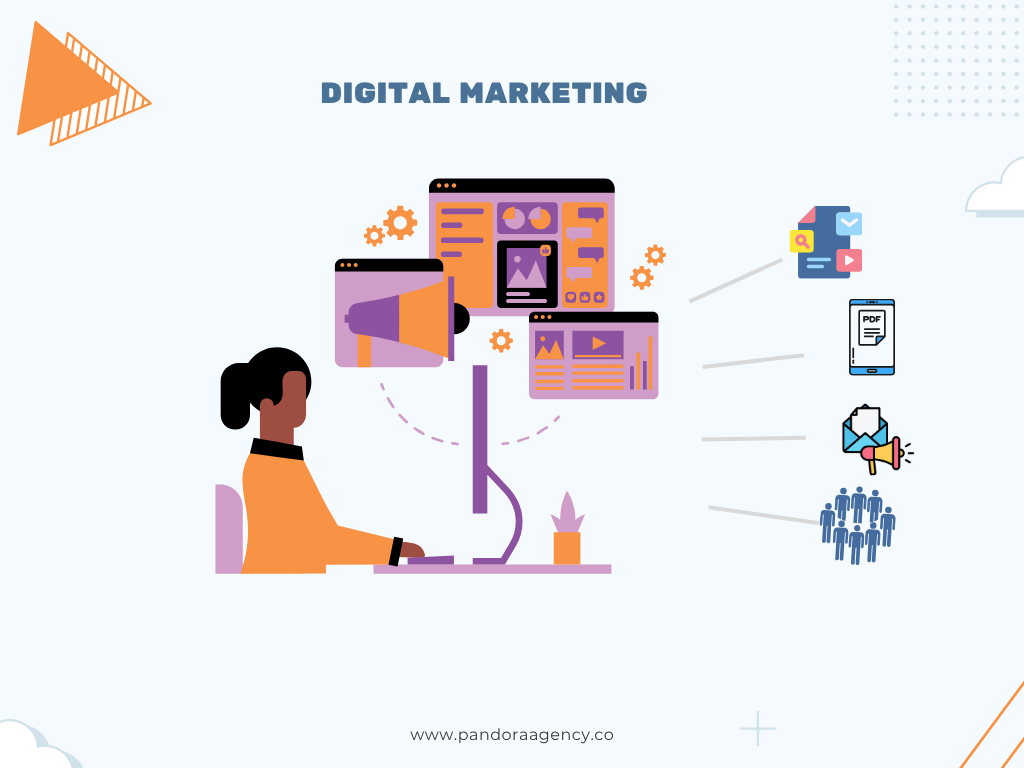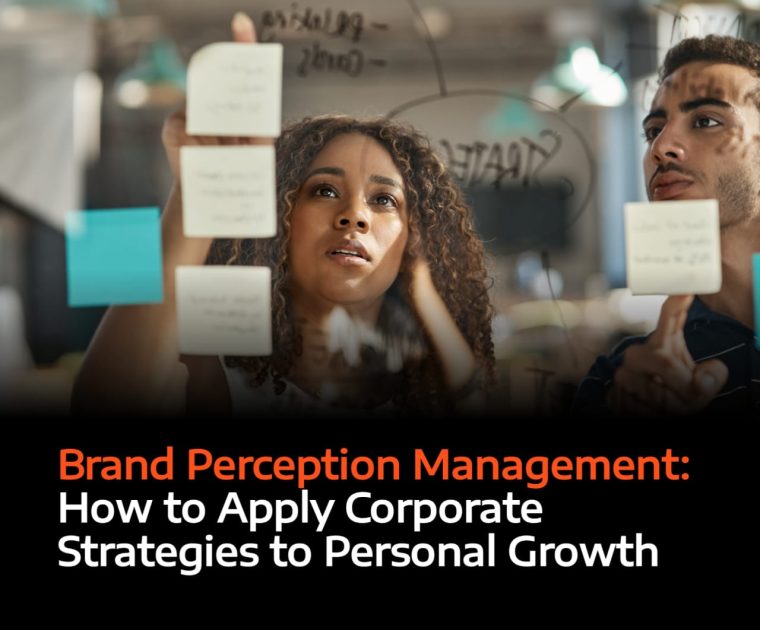In the early 2000s, digital marketing primarily involved banner ads, email marketing, and early forms of Search Engine Optimization (SEO). Social media platforms like MySpace and LinkedIn were emerging, but their marketing potential hadn’t been fully realized yet.
Today, in 2025, digital marketing is characterized by increased AI integration, a focus on personalized and immersive experiences, and the rise of interactive content and video marketing.
This brings increased competition and an oversaturated marketing landscape. But how does a brand stand out and do digital marketing that cuts through the clutter and wins? Let’s explore.
What is Digital Marketing in 2025?
Simply put, digital marketing is how businesses connect with potential customers through the internet and digital devices like smartphones, tablets, and computers.
In 2025, digital marketing involves utilising digital platforms to establish genuine trust, deliver genuine value, and position a business as a go-to resource in a noisy online world, ultimately driving sales.
Digital marketing in 2025 is no longer just about websites, emails, or paid ads. It’s about how brands can genuinely connect with consumers, deliver authentic value, and position themselves as authorities in a noisy online world.
Think about this, there are over 28 million e-commerce websites worldwide, and the US accounts for 50% of them. China continues to lead in e-commerce sales, followed by the US and the UK. The competition is not slowing down.
With AI-generated content flooding search engines and social media, people are craving brands they can rely on. Being present online isn’t enough in 2025. You must be credible, consistent, and clear.
Digital marketing today consists of the following:
Before we dissect each of the above aspects of digital marketing, let’s take a look at why being a trusted, definitive resource matter in 2025 digital marketing. First, it starts with audience trust.
Audience Trust is The New Rules of Digital Marketing
Remember how many e-commerce businesses we said are already in existence? What is even more interesting is that consumer behavior has changed a lot.
In 2025, having a good product and a well-planned marketing strategy is just a part of the game; trust is the invisible currency that determines whether people engage with your brand, buy from you, and recommend you to others.
A study by the Edelman Trust Barometer (2024) revealed that 71% of consumers globally say trusting a brand is more important now than ever before. This is a trend driven by growing misinformation online, AI-generated content, and the oversaturation of sales messages.
Social media platforms, search engines, and consumer behavior all reflect this reality. Whether you’re building your presence on LinkedIn, growing your brand on Instagram, or fighting for visibility on Google, the same principle applies: Trust is your competitive edge.
How To Earn and Keep Trust as a Digital Marketing Strategy
1. Share Accurate, Transparent Information
Today’s digital consumers are sceptical. They’ve been burned by clickbait headlines, AI-generated misinformation, and half-baked promises. Brands that cut through the noise with clear, accurate, and transparent information stand out.
Here are practical ways to execute this:
- On LinkedIn, for instance, you can share data-backed insights, source credible research consistently, and openly acknowledge limitations or industry uncertainties. This is what top brands do to position themselves as trustworthy voices rather than self-promotional noise.
- For search engines like Google, invest in credible blog posts, well-cited thought leadership, and FAQ-driven pages to see better search visibility. Google’s Helpful Content System update (2024) rewards websites that publish well-researched, accurate, and people-first content.
- On Instagram, build trust by being transparent, from showing unedited product photos to revealing behind-the-scenes processes. Users, particularly Millennials and Gen Z, have become experts at spotting inauthentic content.
Takeaway: Fact-check rigorously. Reference credible sources. When in doubt, say you’re still learning; it builds more credibility than false certainty.
2. Show Up Consistently
Trust doesn’t come from one viral post; it comes from showing up reliably over time. This is why LinkedIn’s algorithm favors consistent contributors. According to LinkedIn’s 2024 Creator Tips, accounts that post valuable, engaging content regularly (without spamming) see higher reach and follower growth.
Little wonder that B2B brands like Canva and Semrush consistently show up on LinkedIn, providing valuable education, entertainment, and industry insights week after week.
On Instagram, consistency isn’t just about frequency but visual and message consistency. Your brand must maintain recognizable design elements and tone of voice, building familiarity and, by extension, trust.
Takeaway: Be predictably present. Whether it’s weekly LinkedIn posts, daily Instagram stories, or regular blog updates, showing up consistently reinforces your reliability.
3. Be Accountable and Responsive
People trust brands that are human enough to admit mistakes and proactive enough to engage.
This is why social listening on platforms like Instagram, TikTok, and Twitter is no longer optional. You need to monitor comments and conversations, responding to both praise and criticism in real time.
On platforms like LinkedIn, industry leaders earn respect by engaging with comments, answering questions, and openly addressing concerns rather than disappearing after posting.
Even on Google Reviews, companies that respond to negative reviews constructively often earn more trust than those with only glowing, curated testimonials.
Here’s a real-world example: KFC suffered a major chicken supply failure in the UK in February 2018 when a new logistics provider failed to deliver to 750+ outlets. Within two days, they responded with a bold full-page ad showing their logo rearranged to spell “FCK,” along with a candid apology explaining the situation. The move was praised for its genuineness, humor, and speedy response, it diffused the crisis and actually boosted brand sentiment and public trust
Takeaway: Accountability isn’t a PR crisis tactic; it’s an everyday trust-building tool.

4. Avoid Over-Promising
In the race for attention, it’s tempting to make bold claims. But in 2025, customers value realistic, experience-backed promises over exaggerated guarantees.
It even gets worse on Google, where it penalises websites with misleading meta descriptions or overhyped claims that are not supported by actual content.
On social media platforms like Instagram, influencer fatigue has set in. Audiences are sceptical of overhyped product placements. Micro-influencers who share balanced, honest reviews (highlighting both pros and cons) are now more trusted.
As a brand, you can build trust by offering grounded, honest takes that acknowledge market limitations rather than sugarcoating realities. On platforms like TikTok, audiences prefer influencers and brands that give realistic reviews and show both pros and cons.
Takeaway: Under-promise. Over-deliver. Your audience will thank you.
5. Focus on Long-Term Relationships, Not Just Quick Sales
The biggest shift? Trust grows when you treat marketing as a relationship, not a transaction.
You need to build your community, whether on LinkedIn, Twitter or Instagram, nurturing ongoing conversations, not one-off promotions.
What works include loyalty programs, user-generated content features, and interactive polls that foster two-way relationships, making followers feel seen and valued.
Google also rewards long-term authority signals, which include consistent content publishing, helpful answers on forums like Reddit or Quora, and positive brand mentions over time.
Case in point: B2B SaaS companies like Notion and Slack have focused on building ecosystems where they offer free education, community groups, and product resources long before pitching paid upgrades. The result? Deep-rooted customer trust and advocacy.
Takeaway: Play the long game. Trust isn’t built in a single campaign; it’s nurtured daily.
Related Content: State of AI in Marketing in Nigeria, 2025
We surveyed marketers and brand leaders in Nigeria to learn the rate of AI adoption in their workflow, what they’re using it for, if it makes business sense, and future trends. We had a conversation with a representative of the Advertising Regulatory Council of Nigeria (ARCON) on their AI adoption restriction. All these you’ll find in this concise, easy-to-digest report.
How Content Leadership Makes the Difference in Digital Marketing
The digital world is drowning in content. On YouTube alone, there are approximately 66 million creators, according to data from the creator economy, which includes both established and amateur content creators. The number of YouTube channels is even higher, with over 100 million channels worldwide.
The real question is: Are you adding to the noise or leading the conversation?
Most brands unknowingly add to the noise, rehashing existing ideas, recycling trends, and producing shallow content optimized only for clicks. The result? More digital clutter, less impact.
How to Achieve Content Leadership in Digital Marketing
In 2025, your content either adds to the noise or leads the conversation; there is no in-between. Here are 5 tips to achieve content leadership in digital marketing:
Types of Digital Marketing Every Business Owner Must Know
1. Search Engine Optimization (SEO)
Search Engine Optimization, commonly known as SEO, is the strategic process of improving a website’s visibility on search engines like Google, Bing, and YouTube.
In 2025, SEO has evolved beyond keyword stuffing and backlinks; it’s now centered on creating content that genuinely helps people, satisfies search intent, and earns credibility in the eyes of both users and algorithms.
Modern SEO focuses on deeply understanding what people are searching for and why. It’s about becoming the most reliable answer to the questions your audience is asking.
Search engines today reward websites that
- Demonstrate expertise
- Offer real-world experience, authority, and trustworthiness, a framework Google now calls E-E-A-T.
Websites that fail to provide these signals are rapidly losing visibility.
Brands leading in SEO today prioritize helpful, human-first content. They update their pages regularly, optimize for voice and conversational search, and integrate semantic keywords naturally.
The best SEO practitioners avoid manipulative tactics like keyword stuffing or buying links because Google’s algorithms and users can now detect and penalize these shortcuts swiftly.
2. Content Marketing
Content marketing is the heart of digital marketing in 2025. It’s the strategy of creating and sharing valuable, relevant, and meaningful content to attract and retain a clearly defined audience.
Unlike traditional advertising that interrupts, content marketing aims to engage and educate, making people naturally want to follow, trust, and eventually buy from you.
Great content marketing focuses on solving real problems. Instead of pushing products, successful brands offer original perspectives, insightful guides, and practical resources that genuinely help their audience. This approach positions the brand as a trusted advisor, not just another vendor.
Content marketing is powered by various formats, including blog articles, podcasts, webinars, infographics, downloadable templates, interactive tools, and more.
In today’s landscape, brands that win in content marketing do so by
- Consistently publishing useful resources,
- Integrating SEO best practices, and
- Actively listening to audience feedback.
It’s no longer enough to create content for the sake of visibility. The emphasis is now on producing helpful, people-first content that earns repeat visits and builds long-term trust.
3. Social Media Marketing
Social media marketing is about using platforms like LinkedIn, Instagram, TikTok, and X (formerly Twitter) to build relationships, showcase brand identity, and drive meaningful engagement with your audience.
The best social media strategies emphasize transparency, consistency, and interaction. Brands that succeed are the ones that show up regularly, provide real-time responses, and aren’t afraid to reveal the people and stories behind the brand.
Social media works by creating touchpoints where audiences can engage, ask questions, share feedback, and feel part of a larger conversation.
Audiences now prefer seeing behind-the-scenes content, user-generated posts, and honest reviews over overly polished advertisements. In 2025, social media is less about perfect feeds and more about authentic, community-driven conversations.
Algorithms on LinkedIn, Instagram, and TikTok, for example, reward genuine interaction, such as comments, shares, and saves, more than superficial likes or passive views. It’s about fostering dialogue, not broadcasting.
Best practices in social media marketing today include
- Maintaining visual and message consistency,
- Being timely and responsive,
- Using platform-native content styles and prioritizing human-centred storytelling.
Brands that treat social media as a relationship-building tool rather than a sales channel are earning deeper audience loyalty.
4. Video and Short-Form Content
Video has become the most powerful form of digital communication, and in 2025, short-form video is expected to lead the charge.
From Instagram Reels to YouTube Shorts, TikTok clips to LinkedIn video posts, short, engaging videos are now essential for brands looking to grab attention quickly.
Video content works by combining visual storytelling with sound, movement, and personality. It allows brands to convey complex messages in a more human, accessible way.
A well-crafted 30-second video can build a more emotional connection than a static ad or long-form text ever could.
The success of short-form content comes down to how people consume information today.
With shrinking attention spans and endless scrolling, audiences want content that gets to the point, entertains, educates, or inspires all within seconds.
- Leading brands use short-form video to showcase product demos, share customer success stories, offer quick tips, or reveal behind-the-scenes moments.
- On platforms like TikTok, brands like Duolingo and Ryanair have gained millions of followers by embracing humor, trends, and authentic, unpolished content. On LinkedIn, short video posts from professionals provide personal insights that feel relatable and trustworthy.
The key to success with video is to prioritize authenticity over perfection. People engage with videos that feel real, spontaneous, and human.
Best practices include using captions for accessibility, adding clear calls to action, and optimizing for mobile-first viewing. Brands that understand the language of short-form video are cutting through the noise and building stronger connections faster than ever.
5. Influencer Partnerships
Influencer marketing is when a brand collaborates with a social media creator who is popular in their niche to promote the brand’s products or services.
The most effective influencer partnerships are built on trust, transparency, and long-term collaboration.
Best practices include thoroughly vetting influencers, focusing on relevance over follower count, using clear disclosure for paid content, and encouraging influencers to share their honest experiences rather than scripted promotions.
Influencer marketing has matured significantly, and in 2025, it’s less about chasing celebrities and more about forming strategic partnerships with trusted, relatable creators.
Some influencers may have smaller followings, but their audiences are highly engaged and trust their recommendations.
According to HypeAuditor’s 2025 report, micro-influencers often deliver up to 60% higher engagement rates compared to mega-influencers.
How Does Influencer Partnership Work?
- Influencer partnerships work when there’s genuine alignment between the brand, the influencer, and their audience.
- It’s no longer effective to simply send products and hope for a glowing review. Brands now co-create content with influencers, involve them in product development, and support them in telling authentic stories.
- For example, skincare brands like The Ordinary have collaborated with knowledgeable beauty creators who educate their audiences rather than just promote.
- On LinkedIn, B2B companies partner with respected industry voices to produce thought-leadership content that feels organic and valuable.
In 2025, influencer marketing works best when it feels like a conversation, not a commercial.
6. Email Marketing and Automation
Email marketing is the use of email to connect with, build a relationship with, and promote a brand’s audience, ultimately creating a long-term relationship.
Email remains one of the most reliable tools in digital marketing, used to deliver personalized, timely, and relevant messages that feel like one-to-one conversations.
Despite the rise of social media, email remains a direct line to your audience, one you own. However, with crowded inboxes and rising privacy expectations, brands have had to become more strategic about how they use it. That’s where automation comes in.
Email marketing works by building permission-based lists, segmenting audiences based on behaviour and preferences, and using automation to send the right message at the right time.
Whether it’s a welcome series, abandoned cart reminder, or tailored product recommendation, automated emails allow brands to nurture relationships without overwhelming resources.
How to Win With Email Marketing
- Leading platforms like Klaviyo, Mailchimp, and HubSpot now offer AI-powered segmentation and predictive analytics, making it easier than ever to send highly targeted, effective emails.
- Personalized subject lines, dynamic content blocks, and behavior-triggered messages have become standard practice.
- Successful brands focus on providing value in every email, from helpful resources and exclusive offers to educational content or insider updates.
- They respect frequency preferences and make it easy for recipients to unsubscribe, which ironically builds more trust and reduces list fatigue.
Best practices today emphasize building a high-quality, engaged email list rather than chasing vanity metrics. Here’s what works:
Brands that treat email as a relationship tool rather than a sales megaphone are seeing higher open rates, more conversions, and long-term customer loyalty.
7. Online Communities and Private Groups
Online communities are private groups on platforms like Facebook, Slack, Discord, WhatsApp, and LinkedIn where brands can have deeper, more meaningful connections with their audiences.
The shift toward private spaces is driven by digital fatigue and a desire for more curated, trusted interactions.
Public feeds are crowded, unpredictable, and often driven by algorithms, whereas private groups create spaces for genuine conversations, peer support, and relationship-building that are free from the noise.
How Do Online Communities Work?
- An online community works by bringing together people with shared interests, challenges, or goals.
- For brands, it’s not about hard-selling but about creating value through education, networking, and mutual support.
- Whether it’s a Facebook group for loyal customers, a Slack workspace for industry peers, or a LinkedIn group for professional discussions, these spaces encourage ongoing engagement.
- Successful communities offer exclusive resources, expert insights, behind-the-scenes updates, and opportunities for members to ask questions and share experiences.
Brands like Notion and Zapier have built thriving user communities where people can exchange ideas, troubleshoot issues, and celebrate wins. These groups naturally nurture brand loyalty and advocacy.
Best practices for building and managing communities include setting clear guidelines, showing up consistently as a helpful resource (not just a moderator), and encouraging member-driven conversations.
Communities that feel overly controlled or purely promotional quickly lose their appeal. The most valuable groups create a sense of belonging and shared purpose, making members feel like part of something bigger than just a customer list.
8. AI-Powered Personalization
AI-powered personalization is the use of artificial intelligence to deliver hyper-targeted, individualized marketing experiences based on a person’s preferences, behaviors, and needs.
It enables brands to go beyond generic messaging by leveraging data and machine learning to understand customers and respond with relevant, tailored content in real-time.
Artificial intelligence makes this possible by analyzing massive amounts of data in real time, identifying patterns, and predicting what content, products, or messages will resonate with each person.
From website experiences to email content, product recommendations to ad targeting, AI is quietly working behind the scenes to make marketing feel personal and relevant.
How personalization works
In the B2B space, tools like HubSpot, Mutiny, and Salesforce help businesses deliver personalized website experiences, targeted ads, and automated outreach that align with a prospect’s stage in the buyer journey.
The key to effective AI-powered personalization is data transparency and ethical use. Consumers are becoming more aware of how their data is collected and expect brands to handle it responsibly. Research from Forbes shows that 83% of consumers prefer personalized experiences, but only if their data is handled with care.
Best practices include
- Being upfront about data collection,
- Offering easy opt-outs, focusing on delivering real value (not just more ads), and
- Continuously refining personalization efforts based on customer feedback.
Brands that use AI to create smoother, more relevant experiences without crossing privacy lines are building deeper trust and stronger customer relationships.
Key Takeaway
The digital space is louder, faster, and more crowded than ever, but real influence belongs to the brands people trust. Consumers have developed means of avoiding flashy ads and generic content. Brands that show up consistently, share credible information, and lead with honesty will be the ones customers choose and stick with.
In a world driven by AI and endless options, trust isn’t a nice-to-have; it’s your only real advantage.





This was outstanding.
The reminder that trust is the real competitive edge in 2025 marketing hit hardest (especially in a world drowning in AI-generated noise).
We’re glad you found it insightful!